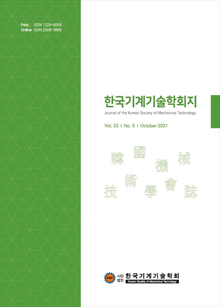간행물
한국기계기술학회지 KCI 등재 Journal of the Korean Society of Mechanical Technology 韓國機械技術學會誌

- 발행기관 한국기계기술학회
- 자료유형 학술지
- 간기 격월간
- ISSN 1229-604X (Print)2092-0385 (Online)
- 수록기간 1999 ~ 2025
- 주제분류 공학 > 기계공학 공학 분류의 다른 간행물
- 십진분류KDC 550DDC 620
권호리스트/논문검색
제16권 제5호 (2014년 10월) 26건
21.
2014.10
구독 인증기관 무료, 개인회원 유료
In case of many products placed on the production line in automobile production, some line is personnel visually identifiable, such as CCTV, while the rest areas are not identifiable. However, because the position of accidents is not scheduled and every accidents should be analyzed at every point, every accidents is not easy because you need to an immediate response. The record cause of the accident is difficult to understand, not until after the accident for the accident cause analysis of fragmentary and mechanical information so that future accidents have difficulty measures be established. To prevent this, the car accident occurred in the manufacturing plant personnel to deploy and monitor in every area of enterprise is too burdensome labor costs too high. In this study, automated car production plant and load transfer system crash, accident collision and records are available for real-time wireless transmission, the administrator determines that situation can be immediately developed the electronic mono rail system(EMS). You will start to develop the control of EMS and stop control is critical for the correct parts first perform CAE analysis to develop a prototype
4,000원
22.
2014.10
구독 인증기관 무료, 개인회원 유료
Automatic continuous manufacturing system is necessary to raise the productivity and strengthen the competitiveness in the wire manufacturing. The automatic wire cutting technology is an important element to link various processes and it is crucial technology to obtain high accuracy and quality of the wire. This study was performed to develop an automatic stainless steel wire cutting equipment that is consist of the first and second cutting equipments besides related devices to cut stainless steel wire. This wire cutting equipment can cut wire with high accuracy, and it can prevent sintering and discoloration
4,000원
23.
2014.10
구독 인증기관 무료, 개인회원 유료
The automotive bumper has the functions of strength, rigidity and fine sight. It protects the driver, front and rear sides of car body through shock absorption at the traffic accident of car. This study investigates the impacts on front side and corner with the low speed of 4.5 km/h by using the model of SUV car body. The models are modelled by CATIA program with three dimensions and are analyzed by the finite element program of ANSYS Explicit STR. The maximum equivalent stresses at impacts of front side(case 1) and corner (case 2) at bumper are 261.72MPa and 365.02MPa respectively. As this stress at case 2 becomes 40% higher than at case 1, the impact of corner is happened easier than at the damage at the impact of front side. These stresses at case 1 and case 2 are shown above the yield stress at material property of steel, it is thought that there are the possibilities of plastic damages at two cases. The maximum deformation and equivalent stress at the support 2 of case 2 become 5 times and 3 times higher than at the support 1 respectively. The damage possibility due to impact at low speed is investigated by the basic analysis result of this study. And this result can be utilized at inspecting the result of impact test on bumper hereafter.
4,000원
24.
2014.10
구독 인증기관 무료, 개인회원 유료
4,000원
25.
2014.10
구독 인증기관 무료, 개인회원 유료
Waste oyster shell is a waste product from oyster-culturing farm and also presents a major disposal problem in itself. The present study is conducted to develop equipments for recycling waste oyster shells etc. Through the processing of the recycling treatment of wasted marine products, it is transfered and used as the other functional materials. The advanced drying and crushing equipments are designed and conducted the performance evaluation. Finally, it was shown that performance of these are superior to that of the other existing equipments.
4,000원
26.
2014.10
구독 인증기관 무료, 개인회원 유료
This paper describes the development of precision gear pump for transmitting source material of chemical machinery. Gear pump design is carried out considering geometry of gear and strength of shaft by CAE program. Teeth of gear is machined by ultra precision grinding, and by inspection of profile and lead, JIS 0-grade gear is manufactured. Through the pump performance test, pump discharge volume per one revolution is in a good agreement with the target values when varying rotational speed and working temperature.
4,000원
1
2

